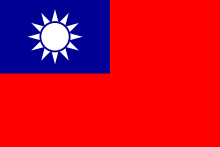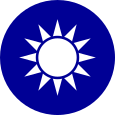This is an old revision of this page, as edited by 209.66.197.28 (talk) at 19:11, 5 February 2016 (→Use of the name). The present address (URL) is a permanent link to this revision, which may differ significantly from the current revision.
Revision as of 19:11, 5 February 2016 by 209.66.197.28 (talk) (→Use of the name)(diff) ← Previous revision | Latest revision (diff) | Newer revision → (diff)Template:Contains Chinese text
| Chinese Taipei | |||||||||||||||||||||||||||||||
|---|---|---|---|---|---|---|---|---|---|---|---|---|---|---|---|---|---|---|---|---|---|---|---|---|---|---|---|---|---|---|---|
| Traditional Chinese | 中華臺北 | ||||||||||||||||||||||||||||||
| Simplified Chinese | 中华臺北 | ||||||||||||||||||||||||||||||
| |||||||||||||||||||||||||||||||
| Separate Customs Territory of Taiwan, Penghu, Kinmen, and Matsu | |||||||||||||||||||||||||||||||
| Traditional Chinese | 臺澎金馬個別關稅領域 | ||||||||||||||||||||||||||||||
| Simplified Chinese | 台澎金马个别关税领域 | ||||||||||||||||||||||||||||||
| |||||||||||||||||||||||||||||||
"Chinese Taipei" is the name for the Republic of China (ROC) agreed upon in the Nagoya Resolution whereby the ROC and the People's Republic of China recognize each other when it comes to the activities of the International Olympic Committee. It has been used by the ROC as the basis when participating in various international organizations and events, including the Olympics, Miss Earth, Paralympics, Asian Games, Asian Para Games, Universiade and FIFA World Cup.
The term is deliberately ambiguous. To the PRC "Chinese Taipei" is ambiguous about the political status or sovereignty of the ROC/Taiwan; to the ROC it is a more inclusive term than just "Taiwan" (which is to the ROC just one part of China, which it, similarly to the PRC, claims to be the rightful government of the nation in its entirety, and to the PRC the use of "Taiwan" as a national name is associated with independence of the area from the PRC) and "Taiwan China" might be construed as a subordinate area to the PRC.
Origins
See also: Two Chinas and Political status of Taiwan



The increased official recognition of the People's Republic of China (PRC) in international activities, such as when accorded recognition in 1971 by the United Nations, instead of that accorded previously to the Republic of China (ROC), saw previously existing diplomatic relations transfer from Taipei to Beijing. The ROC needed to come to a beneficial conclusion to how it would be referred when there was in the same forum participation by the PRC.
The International Olympic Committee (IOC), had informally been using in international Olympic activities a number of names to differentiate the ROC from the PRC. "Taiwan" was used at the Tokyo Games. In 1979, the PRC agreed to participate in IOC activities if the Republic of China was referred to as "Chinese Taipei". The Nagoya Resolution sanctioned that the Beijing Olympic Committee would be called the "Chinese Olympic Committee" and another name would need to be found for the ROC Olympic Committee (ROCOC).
The majority view of the ROC leadership at the time was that they did not want to change, "Taiwan" might imply without China or Chinese being in the name subordination to the PRC, did not represent all the regions/islands of the ROC and did not give the ROC an opportunity to assert when wanted a claim to territory outside of the ROC.
What people refer to as Taiwan is one of several areas or islands (Penghu, Kinmen and Matsu in addition to Taiwan) and Taiwan alone did not reflect the “territorial extent” of the ROCOC. Furthermore, although it is true that most products from Free area of the ROC are labeled “made in Taiwan,” the trade practices of the ROC are such that the regional area of production is used for labeling. Some wines from Kinmen are labeled “made in Kinmen,” just as some perfume is labeled “made in Paris” and not “made in France.”
Taiwan's own government, the ROC government under the Kuomintang (KMT), rejected the designation of "Taiwan, China" on the grounds that this would imply subordination to the PRC. However, it also refused the names "Taiwan" and "Formosa (福爾摩沙)" as a means of reasserting both its claim as the only legitimate government of all of China, and its uncompromising rejection of Taiwan independence. Instead, deriving from the name of its capital city, the ROC government finally formulated the name “Chinese Taipei,” instead of accepting the offer of “Taiwan,” because “Chinese Taipei” signified an uncertain boundary that could exceed the ROC’s actual territory of control of Taiwan, Ponghu, Kinmen and Matsu, whenever the ROC government wished to assert it. It regarded the term Chinese Taipei as both acceptably neutral and hopeful of assent from other interested parties. Its proposal found agreement. Beijing accepted the compromise position that the ROC Olympic Committee could be named the "Chinese Taipei Olympic Committee".
In April 1979, in a plenary session of the IOC, He Zhenliang, a representative of the PRC, stated:
According to the Olympic Charter, only one Chinese Olympic Committee should be recognized. In consideration of the athletes in Taiwan having an opportunity to compete in the Olympic Games, the sports constitution in Taiwan could function as a local organization of China and still remain in the Olympic Movement in the name of the Chinese Taipei Olympic Committee. However, its anthem, flag and constitutions should be changed correspondingly.
In November 1979, in Nagoya, Japan, the International Olympic Committee, and later all other international sports federations, adopted a resolution under which the National Olympic Committee of the ROC would be recognized as the Chinese Taipei Olympic Committee, and its athletes would compete under the name Chinese Taipei. The National Olympic Committee of the ROC boycotted the Summer and Winter Games in protest of not being allowed to use the Republic of China's official flag and national anthem.
The name "Chinese Taipei" was formally accepted by the Government of the Republic of China in 1981. A flag bearing the emblem of its Olympic Committee against a white background as the Chinese Taipei Olympic flag was confirmed in January 1981. The agreement was signed on March 23 in Lausanne by Shen Chia-ming, the President of Chinese Taipei Olympic Committee, and Juan Antonio Samaranch, the President of the IOC. In 1983, National Flag Anthem of the Republic of China was chosen as the anthem of the Chinese Taipei delegation. The Republic of China has competed under this flag and name exclusively at each Games since the 1984 Winter Olympics, as well as at the Paralympics and at other international events (with the Olympic rings replaced by a symbol appropriate to the event).
Translation compromise
Both the Republic of China (ROC) and the People's Republic of China (PRC) agree to use the English name "Chinese Taipei". This is possible because of the ambiguity of the English word "Chinese", which may mean either the state or the culture. In 1979, the International Olympic Committee passed a resolution in Nagoya, Japan, restoring the rights of the Chinese Olympic Committee within the IOC, meanwhile renaming the Taipei-based Olympic Committee "Chinese Taipei Olympic Committee". Since then, and until 1989 the PRC translated "Chinese Taipei" as "Jhongguo Taipei" (traditional chinese: 中國臺北simplified chinese:中國臺北, hanyu pinyin: Jhongguó Táiběi), similar to "Zhongguo Hong Kong", connotating that Taipei is a part of the Chinese state. By contrast, the Republic of China government translated it as "Chunghwa Taipei" (traditional chinese: 中華臺北, Hanyu Pinyin: Jhonghuá Táiběi) in Chinese, which references the term "China" as the cultural or ethnic entity, rather than the state. In 1981 the former Republic of China Olympic Committee confirmed its acceptance of the Nagoya resolution, but translated "Chinese Taipei" to "Chunghwa Taipei". In 1989, the two Olympic committees signed a pact in Hong Kong, clearly defining the use of "Jhonghua Taipei". The PRC had been observing the Hong Kong pact and using "Chunghwa Taipei" in stipulated areas ever since, but on other occasions, the version of "Jhongguo Taipei" was still in use following past practice, especially in official media references. In the London 2012 Olympic Games opening ceremony, when each country's team proceeds in alphabetical order in English (the host country's language), the Chinese Taipei (TPE) team did not follow China (CHN), but instead took a place in the procession as if its name were "Taipei" or Taiwan, following Syria and preceding Tajikistan instead. In Beijing 2008 it followed Japan and preceded the Central African Republic. This ordering was based on the stroke number and order of each team's name in simplified Chinese, the official script in the PRC.
Other East Asian nations have also had to make unique translation decisions. In Japan, the PRC is referred to by its official Japanese name Chūka Jinmin Kyōwakoku (中華人民共和國), but an English transliteration, Chainiizu Taipei (チャイニーズタイペイ), is used for Chinese Taipei.
Use of the name

The name "Chinese Taipei" has spilled into apolitical arenas. The PRC has successfully pressured some religious organizations and civic organizations to refer to the ROC as "Chinese Taipei". The Lions Club used to refer to the Republic of China as "Chinese Taipei", but it now uses the name "Taiwan MD 300". Both the International Monetary Fund. and the World Bank refer to the Taiwan as "Chinese Taipei", and "Taiwan" does not appear on the member countries list of either organization. The ICSU also refers to the Republic of China as "China Taipei", right below "China CAST". The Republic of China is a member economy of APEC, and its official name in the organization is "Chinese Taipei". It has also participated as an invited in the World Health Organization (WHO) under the name Chinese Taipei. It is the only agency of the United Nations that the ROC is able, provided it is invited each year, to participate in since 1971.

In the Miss World 1998, the government of the People's Republic of China pressured the Miss World Organization to rename Miss Republic of China 1998 to "Miss Chinese Taipei"; it has been competing ever since under that designation. The same happened in 2000, but with the Miss Universe Organization. Three years later at the Miss Universe pageant in Panama, the first official Miss China and Miss Taiwan competed alongside each other for the first time in history, prompting the PRC government to again demand that Miss Taiwan assume the title "Miss Chinese Taipei". The contestant in question, Chen Szu-yu, was famously photographed tearfully holding her two sashes. Today, neither Miss Universe nor Miss World, the two largest pageant contests in the world, allow Taiwan's entrants to compete under the Taiwan label. In 2005, the third largest pageant contest, Miss Earth, initially allowed beauty contestant Lee Fan Lin to compete as "Miss Taiwan"; a week into the pageant, however, her sash was updated to "Taiwan ROC". In 2008, the official name for the ROC, was changed to "Chinese Taipei".
The title "Chinese Taipei" leads some people to believe that "Taipei" is a country. During the 2004 Summer Olympics in Athens, while Chinese and Taiwanese news channels referred to the team as Chinese Taipei, most foreign outlets simply called the team Taiwan. For sporting events, the ROC team is abbreviated in Taiwan as the Chunghwa Team (中華隊) ,Chunghwa being a more cultural rather than political variation of the term China), which, in effect, labels it the "Chinese Team".
Starting around the time of the 2004 Summer Olympics, there has been a movement in Taiwan to change all media references to the team to the "Taiwanese Team", and the mainstream Taiwan Television (TTV) is one of the first Taiwanese media outlets to do so. Such usage remains relatively rare, however, and other cable TV channels currently refer to the ROC as the Chunghwa Team and the PRC as the Jhongguo Team, the China team or the mainland China team.
In the 2005 International Children's Games in Coventry, United Kingdom as well as the National Geographic World Championship, the name Chinese Taipei was used too. Chinese Taipei was also the term used by Major League Baseball for the Taiwanese teams that participated in the 2006 and 2009 World Baseball Classic competitions, competing under the Chinese Taipei Olympic flag. The Little League World Series also refers to the Taiwanese teams as Chinese Taipei (although the uniforms states Asia-Pacific).

Other alternative references to the Republic of China
References used in the international context to refer to the Republic of China or Taiwan differ according to the type of the organization.
Separate Customs Territory of Taiwan, Penghu, Kinmen, and Matsu
The World Trade Organization officially uses "Separate Customs Territory of Taiwan, Penghu, Kinmen, and Matsu" for the Republic of China, but "Chinese Taipei" is frequently used in official documents and elsewhere.
Taiwan
International organizations in which the PRC participates generally do not recognize Taiwan or allow its membership. The ROC is recognized by 11 UN member states and the Holy See. Thus, for example, whenever the United Nations makes reference to Taiwan, which does not appear on its member countries list, it uses the designation "Taiwan, Province of China", and organizations that follow UN standards usually do the same, such as the International Organization for Standardization in its listing of ISO 3166-1 country codes. Certain web-based postal address programs also label the country designation name for Taiwan as "Taiwan, Province of China". Inter-governmental organizations use a variety of terms to designate Taiwan.
China/Republic of China

Some non-governmental organizations which the PRC does not participate in continue to use "China" or the "Republic of China". The World Organization of the Scout Movement is one of few international organizations that continue to use the name of "Republic of China", and the ROC affiliate as the Scouts of China. This is because such Scouting in Mainland China is very limited or not really active. Likewise, Freemasonry is outlawed in the PRC and thus the Grand Lodge of China is based in Taiwan.
Countries that maintain diplomatic relations with Taiwan, especially the ROC's older diplomatic affiliates, also refer to the ROC as "China" on occasion; for example, during the funeral of Pope John Paul II, the President of the Republic of China Chen Shui-bian was seated as part of the French alphabetical seating arrangement as the head of state of "Chine" between the first lady of Brazil, and the president of Cameroon.
Other non-specified areas
Taiwan is technically categorized in the United Nations population projections as ‘Other non-specified areas’ within East Asia.
See also
- "Taiwan, China"
- Flag of the Republic of China
- Foreign relations of the Republic of China
- History of the Republic of China
- National Banner Song
- Sport in Taiwan
References
- ^ Catherine K. Lin (2008-08-05). "How 'Chinese Taipei' came about". Taipei Times.
- Eyal Propper. "How China Views its National Security," The Israel Journal of Foreign Affairs, May 2008.
- Brian B. Pendleton, "The People's Republic of China and the Olympic Movement: A Question of Recognition," Unpublished Doctoral dissertation, The University of Alberta, 1978, p. 115.
- ^ Liu, Chin-Ping (2007). 1981年奧會模式簽訂之始末 (PDF) (in Chinese). Retrieved 2010-07-08.
- Chao, Li-Yun (2001-11-02). 「中華臺北」會籍名稱使用事略 (in Chinese). National Policy Foundation. Retrieved 2010-07-08.
- "Winter Olympic Games Lake Placid, USA, 1980". Kiat.net. Retrieved 2013-07-27.
- However, the name of the committee in Chinese continues to be "中華奧林匹克委員會" ("Chinese Olympic Committee"): see Official Website.
- Joe Hung (2002-01-10). "Chinese Taipei". National Policy Foundation. Retrieved 2010-07-09.
- "Mainland plea to end Taiwan's name issue". China Daily. 2008-07-24.
- "China clarifies Taiwan Olympics team name issue". New Ind Press. 2008-07-24.
- "Taiwanese team will compete as 'Chinese Taipei', Beijing confirms". South China Morning Post. 2008-07-24.
- "Stilblüten" (in German).
- "Lions Club Locator". Lions Clubs International. 2008-11-11.
- "IMF reports and publications arranged by country". International Monetary Fund. 2008-11-11.
- "Member Countries & Regions of the World Bank". The World Bank. 2008-11-11.
- "ICSU National Unions". ICSU. 2008-11-11.
- "APEC FAQ: Who are the members of APEC?". Asia Pacific Economic Cooperation. 2008-11-11.
- Katie Reid (May 18, 2009). "Taiwan hopes WHO assembly will help boost its profile". Reuters. Retrieved June 11, 2013.
- "Miss World 2008 Contestants". Miss World. 2008-11-11.
- "Chen Szu-yu with her two sashes".
- "Beauty queen renamed". Taipei Times. 2003-05-23. Retrieved 2012-08-09.
- "85 Beauties Set Their Sights on 'Miss Earth 2008' Crown". Oh My News. 2008-11-11.
- "Rest in peace, `Chinese Taipei'". Taipei Times. 2004-09-01.
- "WTO page for "Separate Customs Territory of Taiwan, Penghu, Kinmen, and Matsu"". Wto.org. Retrieved 2013-07-27.
- "MEMBER INFORMATION: Separate Customs Territory of Taiwan, Penghu, Kinmen and Matsu (Chinese Taipei) and the WTO". World Trade Organization. 2008-11-18.
- "United Nations Infonation". The United Nations. 2008-11-11.
- Although such organizations are established in mainland, there is no or less governmental or CPC support to them.
- Basten, Stuart (2013). "Redefining 'old age' and 'dependency' in the East Asian social policy narrative". Asian Social Policy and Social Work Review.
- "2015 Revision of World Population Prospects". United Nations Department of Economic and Social Affairs.
External links
- Template:Zh-tw 國民體育季刊 No. 156. Focus Topic: Olympic Model
- Chinese Taipei Olympic Committee Official Website
- Swiss Residency Permits Refer the Nationality of ROC Citizens as "Chinese Taipei"

